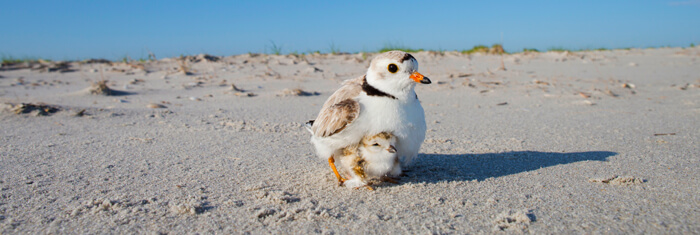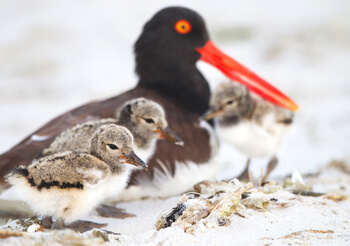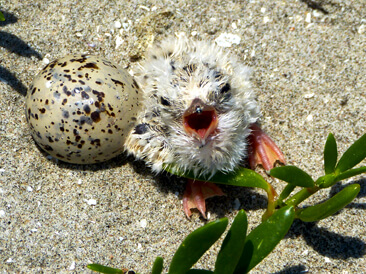Fourth of July Beachgoers Asked to "Fish, Swim, and Play from 50 Yards Away"
 The federally threatened Piping Plover nests on beaches from North Carolina to Maine, and can be impacted by beach-goer activities during the Fourth of July weekend. Photo by Michael Stubblefield. |
(Note to editors: ABC is sending this release out well in advance of July 4th in order to allow you time to schedule interviews with ABC staff to publish an editorial on the issue, should you choose.)
(Washington, D.C., June 13, 2013) As millions of vacationing Americans head to their nearest beach destination for a long weekend of surf and sun, one of the nation's leading bird conservation organizations – American Bird Conservancy (ABC) – is urging beachgoers to be mindful of the many beach-nesting birds that will be tending to young birds and perhaps a few remaining eggs.
“People visiting the beaches are often unaware of the many species of birds that nest in the sands near where they are swimming, fishing, and recreating. As a result, nests can accidentally get trampled, destroyed, or abandoned,” said ABC's Kacy Ray, Gulf Beach-Nesting Bird Conservation Project Officer.
"The best thing for beachgoers to do is to avoid getting close to areas where larger congregations of birds are gathered, and to always respect areas that are roped off or marked with signs designating an area that is used by nesting birds,” says Ray. “The habitat for these birds is diminishing every year due to beach development, erosion, and ever-increasing recreational use, so the birds can really use any break we can give them. They have no other place to go,” Ray said.
Ray points out that it can be difficult for both the year-round resident and the casual vacationer to see the difference between a bird that is simply sitting on the sand and one that is tending eggs or a nest or young.
You know you've entered a nesting area when large groups or individual birds vocalize loudly, dive-bomb your head, or feign injury to lead you away from their nests. If this happens, back away and share the beach so the birds can successfully rear their young.
Ray said that there are special concerns for different regions of the country.
Gulf Coast:
 |
American Oystercatcher chicks under the watchful eye of an adult. Photo by Michael Stubblefield. |
Along the Gulf Coast, you will find Least Terns and Black Skimmers, which nest in colonies. Wilson's and Snowy plovers and American Oystercatchers can also be found, but tend to be spread out in more isolated single-pair territories along the coast.
ABC is leading a Gulf Coast conservation effort that is working to identify and implement protective measures for vulnerable beach-nesting birds such as Least Terns, Black Skimmers, and Snowy and Wilson's plovers. The project utilizes expertise not only from ABC, but from partners throughout the Gulf region, including the Florida Park Service, Pinellas County in Florida, St. Petersburg Audubon Society, National Audubon Society, and Houston Audubon, among others.
Funded by the National Fish and Wildlife Foundation, the project focuses on protecting and monitoring beach-nesting bird habitat in Texas, Louisiana, and Florida. It also includes statewide public awareness campaigns in Texas and Louisiana asking boaters, fishermen, and other recreationists to “Fish, Swim, and Play from 50 Yards Away” from birds nesting on islands and beaches. Regional partners in this effort include Barataria-Terrebonne National Estuary Program, Voice of the Wetlands, and Coastal Bend Bays and Estuaries Program.
“It takes a lot of feet on the ground to raise awareness about birds nesting and raising their young on beaches. ABC and its partners are working in the Tampa Bay region, throughout the Florida Panhandle, in Grand Isle, Louisiana and all up and down the Texas coast to help these birds and their young,” said Ray.
 |
| "Most beach-nesting birds have eggs and young that are cryptically colored to blend in with sand and gravel, and can be hard to see until it is too late" Ray said. An example is this well-camouflaged Least Tern chick, which waits for its sibling to hatch. Photo by Delaina Le Blanc. |
Atlantic Coast:
The federally threatened Piping Plover can be found on Atlantic Coast beaches extending from North Carolina to Maine. They are especially concentrated along the northeastern coast — notably along the beaches of Long Island, New York, and the southern Delmarva Peninsula, Maryland. Other species include the Least Tern, Black Skimmer, American Oystercatcher, and Wilson's Plover.
 |
Black Skimmers nest in the Gulf region, along the Atlantic Coast, and in southern California. Photo by Michael Stubblefield. |
Pacific Coast:
Western beaches host populations of the federally threatened “Western” Snowy Plover, endangered "California" Least Tern, and the Black Oystercatcher (which is more frequently found on rocky, rather than sandy, beaches). While the terns tend to be colonial in their nesting habits, the plovers are more spread out, often favoring sites where rivers enter the ocean.
Ray said that most nesting birds tend to use higher parts of the beach away from the surf, so it should be possible to avoid conflict with beach users so long as people remain close to the water and way from the dunes or higher areas.


















































